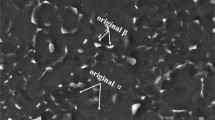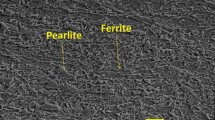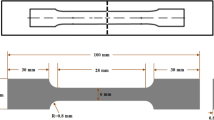Abstract
Electromagnetic forming is a high-speed forming technology, using pulsed Lorentz force to make sheet metal deformed. The fracture behaviour of material during electromagnetic forming is a significant scientific issue in the development of this technology. In the current work, experimental methods are used to investigate the properties and microstructure of laser-welded 2219-T6 aluminium alloy and the fracture behaviour of the weld joint under pulsed Lorentz force. The results indicate that the hardness, strength, ductility, impact toughness of the laser-welded joint are all worse than that of the base metal because of the inhomogeneity of the microstructure and the existence of coarse brittle eutectic phases. This leads to the ductile fracture of laser-welded joint at the initial stage, followed by the sparking and partially melting breaking phenomena, under the pulsed Lorentz force. The molten structure is also observed on the fracture surface of the weld joint after electromagnetic tensile test rather than mechanical high-speed tensile test. During the fracture process under pulsed Lorentz force, local short circuits occur at the ductile crack tip of the weld joint due to the eddy current effect, resulting in the melting of the weld metal. The percentage reduction of area and the dimple sizes in the fracture morphology of the specimen under the conditions of high-speed deformation are larger than that under the condition of quasi-static tensile test, indicating the slight improvement in ductility of the laser-welded joint under high-speed deformation due to the inertial effect and the adiabatic temperature rise from the plastic work. Particularly, the above indicators are even larger under electromagnetic tensile test, revealing extra very slight increase in ductility compared with mechanical high-speed tensile test because of the body force and the additional temperature rise resulting from the Joule heat.




















Similar content being viewed by others
References
Psyk V, Risch D, Kinsey BL, Tekkaya AE, Kleiner M (2011) Electromagnetic forming-a review. J Mater Process Technol 211(5):787–829
Iriondo E, Gonzalez B, Gutierrez M, Vonhout V, Daehn GS, Hayes B (2006) Electromagnetic springback reshaping. In: Proceedings of the 2nd inter conference high speed form—ICHSF 2006, Dortmund, pp 153–160
Thomas JD, Seth M, Daehn GS, Bradley JR, Triantafyllidis N (2007) Forming limits for electromagnetically expanded aluminum alloy tubes: theory and experiment. Acta Mater 55(8):2863–2873
Kim J, Noh HG, Song WJ, Kang BS (2014) Comparative numerical analysis of sheet formed into a V-shaped die using conventional and electromagnetic forming processes. Adv Mech Eng 6:240789–240799
Wang ZQ (2015) Study on electromagnetic incremental forming process of large aluminum alloy curved surface parts. Master Dissertation, Huazhong University of Science and Technology (in Chinese)
Zhu H, Huang L, Li JJ, Li XX, Ma HJ, Wang CM, Ma F (2018) Strengthening mechanism in laser-welded 2219 aluminium alloy under the cooperative effects of aging treatment and pulsed electromagnetic loadings. Mater Sci Eng A 714:124–139
Zhang QX, Huang L, Li JJ, Feng F, Su HL, Ma F, Zhong K (2019) Investigation of dynamic deformation behaviour of large-size sheet metal parts under local Lorentz force. J Mater Process Technol 265:20–33
Pakdil M, Cam G, Kocak M, Erim S (2011) Microstructural and mechanical characterization of laser beam welded AA6056 Al-alloy. Mater Sci Eng A 528(24):7350–7356
Zhao H, White DR, DebRoy T (1999) Current issues and problems in laser welding of automotive aluminium alloys. Int Mater Rev 44(6):238–266
Molian PA, Srivatsan TS (1990) Weldability of aluminium–lithium alloy 2090 using laser welding. J Mater Sci 25(7):3347–3358. https://doi.org/10.1007/BF00587697
Golovashchenko SF (2007) Material formability and coil design in electromagnetic forming. J Mater Eng Perform 16(3):314–320
Ma HJ, Huang L, Wu MQ, Li JJ (2014) Dynamic ductility and fragmentation for aluminum alloy using electromagnetic ring expansion. Procedia Eng 81:787–792
Imbert J, Worswick M, Winkler S, Golovashchenko S, Dmitriev V (2005) Analysis of the increased formability of aluminum alloy sheet formed using electromagnetic forming. SAE Tech Pap 114:6–18
Von WP, Kaierle S, Suttmann O, Overmeyer L (2015) Using pulse shaping to control temporal strain development and solidification cracking in pulsed laser welding of 6082 aluminum alloys. J Mater Process Technol 225:162–169
Yang J, Gang S, Li X, Chen L, Xu F (2010) Typical joint defects in laser welding of aluminium–lithium alloy. In: Proceedings of the 36th Int MATADOR conference. Springer, London, pp 595–598
Liu C, Northwood DO, Bhole SD (2004) Tensile fracture behavior in CO2 laser beam welds of 7075-T6 aluminum alloy. Mater Des 25(7):573–577
Zhang DQ, Jin X, Gao LX, Joo HG, Kang YL (2011) Effect of laser-arc hybrid welding on fracture and corrosion behaviour of AA6061-T6 alloy. Mater Sci Eng A 528(6):2748–2754
Matsunawa A (2000) CO2 laser weldability of aluminium alloys (Report 4). Effect of welding defects on mechanical properties, deformation and fracture of laser welds. Weld Int 14:12–18
Wang ZY, Huang L, Li JJ, Li XX, Zhu H, Ma F, Ma HJ, Cui JJ (2018) Microstructure and properties of friction stir welded 2219 aluminum alloy under heat treatment and electromagnetic forming process. Metals 8:305
Xu JR, Lin QQ, Cui JJ, Li CF (2014) Formability of magnetic pulse uniaxial tension of AZ31 magnesium alloy sheet. Int J Adv Manuf Technol 72(5–8):665–676
Li C, Liu DH, Yu HP, Ji ZB (2009) Research on formability of 5052 aluminum alloy sheet in a quasi-static–dynamic tensile process. Int J Mach Tool Manuf 49(2):117–124
Davis JR (1993) ASM Specialty handbook: aluminum and aluminum alloys. ASM Int, Metals Park
Natan M, Chihoski RA (1983) Relationship between microstructure, hardness and electrical conductivity of 2219 aluminium. J Mater Sci 18(11):3288–3298. https://doi.org/10.1007/BF00544153
MatWeb. In: http://www.matweb.com/index.aspx
Huang C, Kou S (2001) Partially melted zone in aluminum welds-solute segregation and mechanical behavior. Weld J 80(1):9–17
Stefanescu D (2015) Science and engineering of casting solidification, 3rd edn. Springer, London
Fuloria D, Lee PD (2009) An X-ray microtomographic and finite element modeling approach for the prediction of semi-solid deformation behaviour in Al–Cu alloys. Acta Mater 57(18):5554–5562
Ma HJ, Huang L, Tian Y, Li JJ (2014) Effects of strain rate on dynamic mechanical behavior and microstructure evolution of 5A02-O aluminum alloy. Mater Sci Eng A 606:233–239
Kapoor R, Nemat-Nasser S (1998) Determination of temperature rise during high strain rate deformation. Mech Mater 27(1):1–12
Balanethiram VS, Daehn GS (1994) Hyperplasticity: increased forming limits at high workpiece velocity. Scr Metall 30(4):515–520
Liu DH, Zhou WH, Li CF (2013) Influence of body force effect of the pulsed magnetic forces on the dynamic forming limits of AA5052 sheets. J Plast Eng 20(6):62–67 (in Chinese)
Li N, Yu HP, Xu Z, Fan ZS, Liu L (2016) Electromagnetic forming facilitates the transition of deformation mechanism in 5052 aluminum alloy. Mater Sci Eng A 673:222–232
Luo WY, Huang L, Li JJ, Liu XL, Wang ZQ (2014) A novel multi-layer coil for a large and thick-walled component by electromagnetic forming. J Mater Process Technol 214(11):2811–2819
Lu L, Shen YF, Chen XH, Qian LH, Lu K (2004) Ultrahigh strength and high electrical conductivity in copper. Science 304(5669):422–426
Andrews PV, West MB, Robeson CR (1969) The effect of grain boundaries on the electrical resistivity of polycrystalline copper and aluminium. Philos Mag 19(161):887–898
Acknowledgements
This work was supported by the National Natural Science Foundation of China (Grant Nos. 51575206 and 51435007); the FP7 People: Marie-Curie Actions (Grant No. FP7-PEOPLE-2012-IRSES-318968); the Innovation Funds for Aerospace Science and Technology from China Aerospace Science and Technology Corporation (Grant No. CASC150704); the Science Fund of State Key Laboratory of Advanced Design and Manufacturing for Vehicle Body (Grant No. 31615006); and the Fundamental Research Funds for the Central University (Grant No. 2016YXZD055).
Author information
Authors and Affiliations
Corresponding author
Ethics declarations
Conflict of interest
The authors declare that there is no conflict of interests regarding the publication of this article.
Additional information
Publisher's Note
Springer Nature remains neutral with regard to jurisdictional claims in published maps and institutional affiliations.
Rights and permissions
About this article
Cite this article
Zhu, H., Huang, L., Wang, Z. et al. Fracture behaviour of laser-welded 2219-T6 aluminium alloy under pulsed Lorentz force. J Mater Sci 54, 9857–9874 (2019). https://doi.org/10.1007/s10853-019-03588-4
Received:
Accepted:
Published:
Issue Date:
DOI: https://doi.org/10.1007/s10853-019-03588-4




